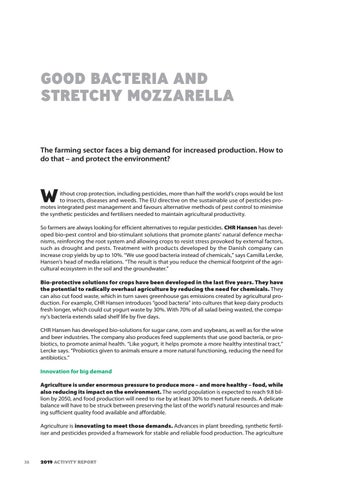GOOD BACTERIA AND STRETCHY MOZZARELLA
The farming sector faces a big demand for increased production. How to do that – and protect the environment?
W
ithout crop protection, including pesticides, more than half the world’s crops would be lost to insects, diseases and weeds. The EU directive on the sustainable use of pesticides promotes integrated pest management and favours alternative methods of pest control to minimise the synthetic pesticides and fertilisers needed to maintain agricultural productivity. So farmers are always looking for efficient alternatives to regular pesticides. CHR Hansen has developed bio-pest control and bio-stimulant solutions that promote plants’ natural defence mechanisms, reinforcing the root system and allowing crops to resist stress provoked by external factors, such as drought and pests. Treatment with products developed by the Danish company can increase crop yields by up to 10%. “We use good bacteria instead of chemicals,” says Camilla Lercke, Hansen’s head of media relations. “The result is that you reduce the chemical footprint of the agricultural ecosystem in the soil and the groundwater.” Bio-protective solutions for crops have been developed in the last five years. They have the potential to radically overhaul agriculture by reducing the need for chemicals. They can also cut food waste, which in turn saves greenhouse gas emissions created by agricultural production. For example, CHR Hansen introduces “good bacteria” into cultures that keep dairy products fresh longer, which could cut yogurt waste by 30%. With 70% of all salad being wasted, the company’s bacteria extends salad shelf life by five days. CHR Hansen has developed bio-solutions for sugar cane, corn and soybeans, as well as for the wine and beer industries. The company also produces feed supplements that use good bacteria, or probiotics, to promote animal health. “Like yogurt, it helps promote a more healthy intestinal tract,” Lercke says. “Probiotics given to animals ensure a more natural functioning, reducing the need for antibiotics.” Innovation for big demand Agriculture is under enormous pressure to produce more – and more healthy – food, while also reducing its impact on the environment. The world population is expected to reach 9.8 billion by 2050, and food production will need to rise by at least 30% to meet future needs. A delicate balance will have to be struck between preserving the last of the world’s natural resources and making sufficient quality food available and affordable. Agriculture is innovating to meet those demands. Advances in plant breeding, synthetic fertiliser and pesticides provided a framework for stable and reliable food production. The agriculture
38
2019 ACTIVITY REPORT
